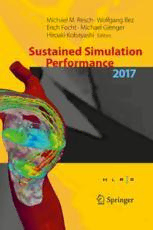Table Of ContentMichael M. Resch · Wolfgang Bez
Erich Focht · Michael Gienger
Hiroaki Kobayashi Editors
SSuussttaaiinneedd SSiimmuullaattiioonn
PPeeeeerrrrrfffffooooorrrrrmmmmmaaaaannnnnccccceeeee
2017
123
Sustained Simulation Performance 2017
Michael M. Resch • Wolfgang Bez (cid:129) Erich Focht (cid:129)
Michael Gienger (cid:129) Hiroaki Kobayashi
Editors
Sustained Simulation
Performance 2017
Proceedings of the Joint Workshop
on Sustained Simulation Performance,
University of Stuttgart (HLRS)
and Tohoku University, 2017
123
Editors
MichaelM.Resch WolfgangBez
HighPerformanceComputing NECHighPerformanceComputing
Center(HLRS) EuropeGmbH
UniversityofStuttgart DuRsseldorf,Germany
Stuttgart,Germany
ErichFocht MichaelGienger
NECHighPerformanceComputing HighPerformanceComputing
EuropeGmbH Center(HLRS)
Stuttgart,Germany UniversityofStuttgart
Stuttgart,Germany
HiroakiKobayashi
CyberscienceCenter
TohokuUniversity
Sendai,Japan
FigureonFrontCover:Streamlineandslicevisualisationofthevelocityfieldatpeaksystoleinanaortic
arcwithaneurysm.Thevortexstructuresintheascendingaorticarcaswellastheaneurysmarevisualised
bythegrey-coloured,transparentisosurface.ThedataprovidedbyFraunhoferMEVISarerecordedby
phasecontrastmagnetresonanceimagingandserveasthecalibration andtestdataforthetwopaper
contributionsofUweKüster,AndreasRuoppandRalfSchneider.
ISBN978-3-319-66895-6 ISBN978-3-319-66896-3 (eBook)
DOI10.1007/978-3-319-66896-3
LibraryofCongressControlNumber:2017955381
Mathematics Subject Classification (2010): 65-XX, 65Exx, 65Fxx, 65Kxx, 68-XX, 68Mxx, 68Uxx,
68Wxx,70-XX,70Fxx,70Gxx,76-XX,76Fxx,76Mxx,92-XX,92Cxx
©SpringerInternationalPublishingAG2017
Thisworkissubjecttocopyright.AllrightsarereservedbythePublisher,whetherthewholeorpartof
thematerialisconcerned,specificallytherightsoftranslation,reprinting,reuseofillustrations,recitation,
broadcasting,reproductiononmicrofilmsorinanyotherphysicalway,andtransmissionorinformation
storageandretrieval,electronicadaptation,computersoftware,orbysimilarordissimilarmethodology
nowknownorhereafterdeveloped.
Theuseofgeneraldescriptivenames,registerednames,trademarks,servicemarks,etc.inthispublication
doesnotimply,evenintheabsenceofaspecificstatement,thatsuchnamesareexemptfromtherelevant
protectivelawsandregulationsandthereforefreeforgeneraluse.
Thepublisher,theauthorsandtheeditorsaresafetoassumethattheadviceandinformationinthisbook
arebelievedtobetrueandaccurateatthedateofpublication.Neitherthepublishernortheauthorsor
theeditorsgiveawarranty,expressorimplied,withrespecttothematerialcontainedhereinorforany
errorsoromissionsthatmayhavebeenmade.Thepublisherremainsneutralwithregardtojurisdictional
claimsinpublishedmapsandinstitutionalaffiliations.
Printedonacid-freepaper
ThisSpringerimprintispublishedbySpringerNature
TheregisteredcompanyisSpringerInternationalPublishingAG
Theregisteredcompanyaddressis:Gewerbestrasse11,6330Cham,Switzerland
Preface
ThefieldofHighPerformanceComputingiscurrentlyundergoingamajorparadigm
shift.Firstly,large-scalesupercomputingsystemswithmassivelyimprovednumber
crunching capabilities are now available to computational scientists all over the
world.Atthesametime,ourknowledgeofhowtomostefficientlyexploitmodern
processorsandperformanceachievementsisgrowingbyleapsandbounds.
However, many domains of computational science have reached a saturation
point with regard to their problem size: many scientists no longer wish to solve
largerproblems.Instead,theyaimtosolvesmallerproblemsinashorteramountof
time,so asto quicklygainknowledgeandrecognisepotentialissuesearlyon.Yet
the currentarchitecturesare much better suited to addressing large problemsthan
theyareforthemorerelevantsmallerproblemsizes.
This particular series of workshops focuses on Sustained Simulation Perfor-
mance,i.e.HighPerformanceComputingforstate-of-the-artapplicationusecases,
rather than on peak performance, which is the scope of artificial problem sizes.
The series of workshops was first established in 2004 under the name Teraflop
Workshop and was renamed Workshop for Sustained Simulation Performance in
2012.Ingeneral,thescopeoftheworkshopserieshasexpandedfromoptimisation
for vector computers only to future challenges, productivity, and exploitation of
currentandfutureHighPerformanceComputingsystems.
This book presents the combined outcomes of the 24th and 25th workshops
in the series. The 24th workshop was held at the High Performance Computing
Center, Stuttgart, Germany, in December 2016. The subsequent 25th workshop
was held in March 2017 at the Cyberscience Center, Tohoku University, Japan.
The topics studied by the contributed papers include developing novel system
management concepts (Part I), leveraging innovative mathematical methods and
approaches (Part II), applying optimisation as well as vectorisation techniques
(PartIII),implementingComputationalFluidDynamicsapplications(PartIV),and
finally,exploitingHighPerformanceDataAnalytics(PartV).
v
vi Preface
We would like to thank all the contributors and organisers of this book and
the Sustained Simulation Performance project. We especially thank Prof. Hiroaki
Kobayashi for the close collaboration over the past years and look forward to
intensifyingourcooperationinthefuture.
Stuttgart,Germany MichaelM.Resch
July2017 MichaelGienger
Contents
PartI SystemManagement
TheoryandPracticeofEfficientSupercomputerManagement ............ 3
VadimVoevodin
TowardsASoftwareDefinedSecureDataStagingMechanism............. 15
Susumu Date, Takashi Yoshikawa, Kazunori Nozaki, Yasuhiro
Watashiba, YoshiyukiKido, Masahiko Takahashi, Masaya Muraki,
andShinjiShimojo
PartII MathematicalMethodsandApproaches
TheNumericalApproximationofKoopmanModesofaNonlinear
OperatorAlongaTrajectory ................................................... 27
UweKüster,RalfSchneider,andAndreasRuopp
PartIII OptimisationandVectorisation
Code Modernization Tools for Assisting Users in Migrating
toFutureGenerationsofSupercomputers.................................... 55
RituAroraandLarsKoesterke
VectorizationofHigh-OrderDGinAtelesfortheNECSX-ACE .......... 75
HaraldKlimach,JiaxingQi,StephanWalter,andSabineRoller
VectorizationofCellularAutomaton-BasedLabelingof3-DBinary
Lattices............................................................................ 89
PeterZinterhof
PartIV ComputationalFluidDynamics
TurbulenceinaFluidStratifiedbyaHighPrandtl-NumberScalar ....... 113
ShinyaOkinoandHideshiHanazaki
vii
viii Contents
Wavelet-BasedCompressionofVolumetricCFDDataSets................. 123
PatrickVoglerandUlrichRist
ValidationofParticle-LadenLarge-EddySimulation
UsingHPCSystems.............................................................. 137
KonstantinFröhlich,LennartSchneiders,MatthiasMeinke,
andWolfgangSchröder
CoupledSimulationwithTwoCouplingApproaches
onParallelSystems .............................................................. 151
NedaEbrahimiPour,VerenaKrupp,HaraldKlimach,andSabineRoller
MRI-BasedComputationalHemodynamicsinPatients..................... 165
AndreasRuoppandRalfSchneider
PartV HighPerformanceDataAnalytics
ADataAnalyticsPipelineforSmartHealthcareApplications.............. 181
ChonhoLee,SeiyaMurata,KoboIshigaki,andSusumuDate
Part I
System Management
Theory and Practice of Efficient Supercomputer
Management
VadimVoevodin
Abstract Theefficiencyof usingmodernsupercomputersystemsisverylow due
to theirhighcomplexity.Itis gettingharderto controlthe state of supercomputer,
but the cost of low efficiency can be very significant. In order to solve this issue,
software for efficient supercomputermanagementis needed. This paper describes
a set of tools being developed in Research Computing Center of Lomonosov
Moscow State University (RCC MSU) that is intended to provide a holistic
approachtoefficiencyanalysisfromdifferentpointsofview.Efficiencyofparticular
user applications and whole supercomputer job flow, efficiency of computational
resources utilization, supercomputer reliability, HPC facility management—all
thesequestionsarebeingstudiedbythedescribedtools.
1 Introduction
Modern supercomputing system consists of a huge amount of different software
andhardwarecomponents:computenodes,network,storage,systemsoftwaretools,
softwarepackages,etc.Ifwewanttoachieveefficientsupercomputermanagement,
we need to think about all behavior aspects of these components.How efficiently
users of supercomputer center consume computational resources, what jobs they
run, what projects they form, how efficiently partitions and quotas are organized,
issystemsoftwareconfiguredproperly—allofthese(andnotonlythese)questions
needtobetakenintoaccount,otherwisetheefficiencyofthesupercomputerusage
can be significantly decreased. This means that we need to control everything
happeninginthesupercomputer.
Asthesupercomputersaregettingbiggerandmorecomplex,thistaskisgetting
harderandharder.Thisexplainsthefactthattheefficiencyofmostsupercomputing
systems is very low. For example, the average Flops performance of one core on
oldMSUsystem calledChebyshevfor3daysisjustabove3%[17].Thesituation
isquitethesameonmanyothercurrentsupercomputersystems.
V.Voevodin((cid:2))
ResearchComputingCenterofLomonosovMoscowStateUniversity,Moscow,Russia
e-mail:vadim@parallel.ru
©SpringerInternationalPublishingAG2017 3
M.M.Reschetal.(eds.),SustainedSimulationPerformance2017,
DOI10.1007/978-3-319-66896-3_1

